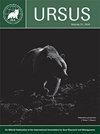Movement and activity of reintroduced giant pandas
IF 0.8
4区 生物学
Q4 ZOOLOGY
引用次数: 5
Abstract
Abstract: Wild populations of giant pandas (Ailuropoda melanoleuca) have steadily increased in the past 2 decades, but the species' distribution remains highly fragmented. Since 2009, an introduction program has worked to rescue the giant panda population of Liziping National Nature Reserve in southwestern Sichuan Province, China. Using Global Positioning System and activity collar data collected between May 2011 and March 2016, we investigated the post-release behavior of the first 5 pandas introduced to Liziping, 4 of which were bred in captivity. Using a change-point analysis, we tested several models of post-release adjustment to the habitat. We found that it took 3–4 months for captive-bred individuals to exhibit movement patterns characteristic of their long-term behavior. Furthermore, we found that, for these individuals, post-adjustment behavior varied by season, with activity levels peaking between May and July, a period of high resource availability. This also corresponded with a decrease in large movement events, where individuals were less likely to travel long distances quickly during these months. Unlike wild giant pandas in more northerly reserves, the 5 pandas released in Liziping (both captive-bred and translocated) did not exhibit any seasonal migration between elevations. Finally, we found that our study individuals had 2 daily periods of activity, which was comparable to those reported in the literature for wild individuals. Our results suggest that captive-bred giant pandas are able to successfully adjust to the wild and, after a period of adjustment, settle into long-term behavior patterns.重新引进的大熊猫的运动和活动
摘要:近20年来,大熊猫(Ailuropoda melanoleuca)野生种群数量稳步增加,但物种分布仍然高度分散。自2009年以来,一项引进计划一直致力于拯救中国四川省西南部黎子坪国家级自然保护区的大熊猫种群。利用2011年5月至2016年3月收集的全球定位系统和活动项圈数据,我们调查了首批5只引入李子坪的大熊猫的释放后行为,其中4只是人工饲养的。使用变化点分析,我们测试了几种释放后栖息地调整模型。我们发现,圈养繁殖的个体需要3-4个月的时间才能表现出长期行为特征的运动模式。此外,我们发现,对于这些个体,调整后的行为随季节而变化,活动水平在5月至7月达到峰值,这是资源可用性高的时期。这也与大型运动活动的减少相对应,在这几个月里,个体不太可能进行长距离快速旅行。与北方自然保护区的野生大熊猫不同,在栗子坪放生的5只大熊猫(包括人工饲养的和迁移的)没有表现出任何季节性的海拔迁徙。最后,我们发现我们的研究个体每天有2个活动期,这与文献中报道的野生个体相当。我们的研究结果表明,人工饲养的大熊猫能够成功地适应野外环境,经过一段时间的调整,形成长期的行为模式。
本文章由计算机程序翻译,如有差异,请以英文原文为准。
求助全文
约1分钟内获得全文
求助全文
来源期刊

Ursus
生物-动物学
CiteScore
2.00
自引率
15.40%
发文量
12
审稿时长
>12 weeks
期刊介绍:
Ursus includes a variety of articles on all aspects of bear management and research worldwide. Original manuscripts are welcome. In addition to manuscripts reporting original research, submissions may be based on thoughtful review and synthesis of previously-reported information, innovative philosophies and opinions, and public policy or legal aspects of wildlife conservation. Notes of general interest are also welcome. Invited manuscripts will be clearly identified, but will still be subject to peer review. All manuscripts must be in English. All manuscripts are peer-reviewed, and subject to rigorous editorial standards.
 求助内容:
求助内容: 应助结果提醒方式:
应助结果提醒方式:


